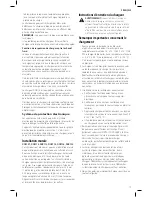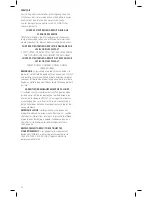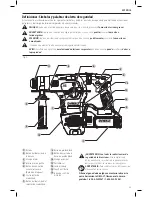
English
10
WARNING:
Drill may stall if overloaded causing a
sudden twist. Always expect the stall. Grip the drill
firmly to control the twisting action and avoid injury.
Operation Modes (Fig. J)
WARNING:
Do not select the operating mode when
the tool is running.
CAUTION:
Never use in Rotary Drilling or Rotary
Hammering mode with a chisel bit in the bit holder.
Personal injury and damage to the the tool may result.
Your tool is equipped with a mode selector dial
6
to
select the mode appropriate to desired operation.
symbol
Mode
Application
Rotary Drilling
Screwdriving
Drilling into steel, wood
and plastics
Rotary
hammering
Drilling into concrete
and masonry
hammering
only
Light chipping
To select an operating mode:
1. Depress the mode selector release button
7
.
2. Rotate the mode selector dial so that the arrow points to
the symbol corresponding for the desired mode.
Fig. J
7
6
nOTE:
The arrow on the mode selector dial
6
must be
pointing at a mode symbol at all times. There are no
operable positions in between. It may be necessary to briefly
run the motor after having changed from 'hammering only'
to 'rotary' modes in order to align the gears.
Performing an Application (Fig. A, K)
WARNING: TO REDUCE THE RISK OF PERSONAL
INJURY, ALWAYS
ensure workpiece is anchored or
clamped firmly. If drilling thin material, use a wood
“back-up” block to prevent damage to the material.
WARNING:
Always wait until the motor has come to
a complete standstill before changing the direction
of rotation.
1. Choose and install the appropriate chuck, adapter, and/
or bit onto to the tool. Refer to
Bit and Bit Holder
.
2. Using the mode selector dial
6
, select the mode
appropriate to desired application.
Refer to
Operation Modes
.
3. Adjust the side handle
3
as necessary.
4. Select the direction of rotation using the forward/
reverse button
4
. When changing the position of the
control button, be sure the trigger is released.
-
To select forward rotation, press the for ward/re verse
control button on the right side of the tool.
-
To select reverse, press the forward/reverse control
button on the left side of the tool.
nOTE:
The center position of the control button
locks the tool in the off position.
Fig. K
6
3
12
5
4
5. Place the bit/chisel on the desired location.
6. Depress the trigger switch
5
. The farther you depress
the trigger switch, the faster the tool will operate. For
maximum tool life, use variable speed only for starting
holes or fasteners.
nOTE:
Depending on your tool, depressing the trigger
switch activates a worklight
12
designed to illuminate
the immediate work surface. Refer to
Components
. The
worklight will automatically turn off shortly after the
trigger switch is released. The worklight is not intended
to be used as a flashlight.
7. To stop the hammer, release the switch.
Recommendations for Tool Operation
• Large (5/16" to 1/2" [7.9 mm to 12.7 mm]) holes in steel
can be made easier if a pilot hole (5/32" to 3/16" [4 mm
to 4.8 mm]) is drilled first.
• When drilling, always apply pressure in a straight line
with the bit, but do not push hard enough to stall the
motor or deflect the bit. A smooth even flow of material
indicates the proper drilling rate.
• If drilling thin material or material that is prone to
splinter, use a wood “back-up” block to prevent damage
to the work piece.
WARNING:
• Do not use this tool to mix or pump easily
combustible or explosive fluids (benzine,
alcohol, etc.).
• Do not mix or stir inflammable liquids
labelled accordingly.













































